
eBook - ePub
V14 Certification: Teradata Basics
Tom Coffing, John Nolan
This is a test
Buch teilen
- 668 Seiten
- English
- ePUB (handyfreundlich)
- Über iOS und Android verfügbar
eBook - ePub
V14 Certification: Teradata Basics
Tom Coffing, John Nolan
Angaben zum Buch
Buchvorschau
Inhaltsverzeichnis
Quellenangaben
Über dieses Buch
You are going to love this book because your confidence and knowledge will soar. V14 Certification: Teradata Basics has been designed to help you pass the test, but it is so much more. It is an incredible reference guide, learning tool, and foundation for passing all the tests and becoming a Teradata Certified Master.
Häufig gestellte Fragen
Wie kann ich mein Abo kündigen?
Gehe einfach zum Kontobereich in den Einstellungen und klicke auf „Abo kündigen“ – ganz einfach. Nachdem du gekündigt hast, bleibt deine Mitgliedschaft für den verbleibenden Abozeitraum, den du bereits bezahlt hast, aktiv. Mehr Informationen hier.
(Wie) Kann ich Bücher herunterladen?
Derzeit stehen all unsere auf Mobilgeräte reagierenden ePub-Bücher zum Download über die App zur Verfügung. Die meisten unserer PDFs stehen ebenfalls zum Download bereit; wir arbeiten daran, auch die übrigen PDFs zum Download anzubieten, bei denen dies aktuell noch nicht möglich ist. Weitere Informationen hier.
Welcher Unterschied besteht bei den Preisen zwischen den Aboplänen?
Mit beiden Aboplänen erhältst du vollen Zugang zur Bibliothek und allen Funktionen von Perlego. Die einzigen Unterschiede bestehen im Preis und dem Abozeitraum: Mit dem Jahresabo sparst du auf 12 Monate gerechnet im Vergleich zum Monatsabo rund 30 %.
Was ist Perlego?
Wir sind ein Online-Abodienst für Lehrbücher, bei dem du für weniger als den Preis eines einzelnen Buches pro Monat Zugang zu einer ganzen Online-Bibliothek erhältst. Mit über 1 Million Büchern zu über 1.000 verschiedenen Themen haben wir bestimmt alles, was du brauchst! Weitere Informationen hier.
Unterstützt Perlego Text-zu-Sprache?
Achte auf das Symbol zum Vorlesen in deinem nächsten Buch, um zu sehen, ob du es dir auch anhören kannst. Bei diesem Tool wird dir Text laut vorgelesen, wobei der Text beim Vorlesen auch grafisch hervorgehoben wird. Du kannst das Vorlesen jederzeit anhalten, beschleunigen und verlangsamen. Weitere Informationen hier.
Ist V14 Certification: Teradata Basics als Online-PDF/ePub verfügbar?
Ja, du hast Zugang zu V14 Certification: Teradata Basics von Tom Coffing, John Nolan im PDF- und/oder ePub-Format sowie zu anderen beliebten Büchern aus Computer Science & Data Warehousing. Aus unserem Katalog stehen dir über 1 Million Bücher zur Verfügung.
Information
Thema
Computer ScienceThema
Data WarehousingChapter 1 – Teradata Basics and Data Warehouse Concepts
“I find that the harder I work the more luck I seem to have.”
– Thomas Jefferson
Passing Your Teradata Certification Tests
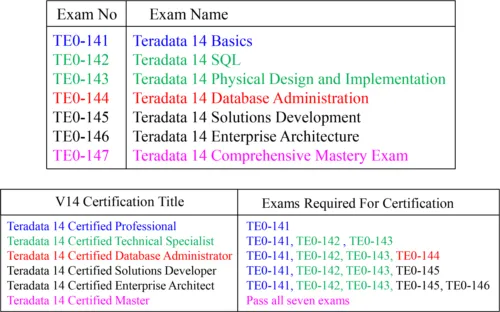
All exams must be taken and passed in the order listed. Teradata V12 Masters can take one test to achieve a V14 Masters Upgrade and that is TE0-147. Go to www.prometric.com/Teradata to register for an exam.
What is Parallel Processing?
“After enlightenment, the laundry”
- Zen Proverb

“After parallel processing the laundry, enlightenment!”
-Teradata Zen Proverb
Two guys were having fun on a Saturday night when one said, “I’ve got to go and do my laundry.” The other said, “What?!” The man explained that if he went to the laundry mat the next morning, he would be lucky to get one machine and be there all day. But, if he went on Saturday night, he could get all the machines. Then, he could do all his wash and dry in two hours. Now that’s parallel processing mixed in with a little dry humor!
The Basics of a Single Computer

Data on disk does absolutely nothing. When data is requested, the computer moves the data one block at a time from disk into memory. Once the data is in memory, it is processed by the CPU at lightning speed. All computers work this way. The "Achilles Heel" of every computer is the slow process of moving data from disk to memory. That is all you need to know to be a computer expert!
Teradata Parallel Processes Data
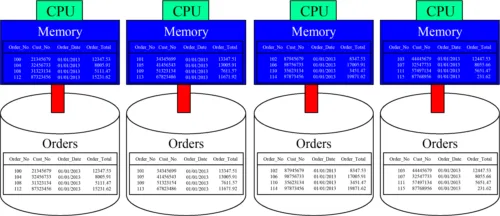
Teradata has been the pioneer in parallel processing since 1988 when Wells Fargo bought the first Teradata system. In the picture above, you see that we have 16 orders with four orders placed on each disk. It appears to be four separate computers, but this is one system. Teradata systems work just like a basic computer as they still need to move data from disk into memory, but Teradata divides and conquers.
Parallel Architecture
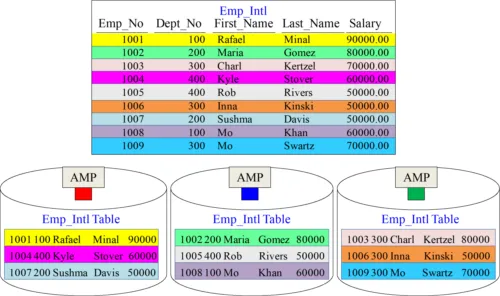
The rows of a Teradata table are spread across the AMPs, so each AMP can then process an equal amount of the rows when a USER queries the table.
The Teradata Architecture
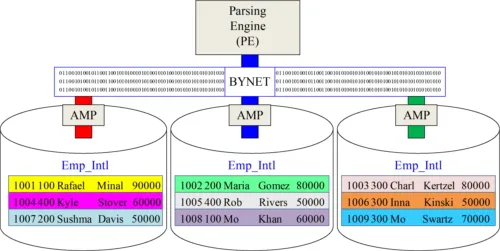
The Parsing Engine (PE) takes the User’s SQL and builds a Plan for each AMP to follow to retrieve the data. Parallel Processing is all about each AMP doing an equal amount of the work. If they start at the same time and end the same time, they are performing true Parallel Processing. All communication is done over the BYNET.
All Teradata Tables are spread across ALL AMPS

Each table dreams of spreading their rows equally across the AMPs. Above, are three tables with each table holding 9 rows (3-rows per AMP).
Teradata Systems can Add AMPs for Linear Scalability
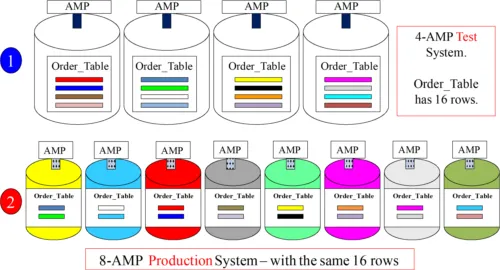
Linear Scalability means if you double your AMPs and their supporting nodes the performance doubles! System number one has only 4-AMPs, but system two has 8-AMPs and is twice as fast. When a customer buys more hardware, they are adding AMPs to the system. Once the hardware is configured, the AMPs will redistribute the data to include the new AMPs.
Understand that Teradata can scale to incredible size
“If you do what you've always done, you'll get what you've always got.”
- Anonymous
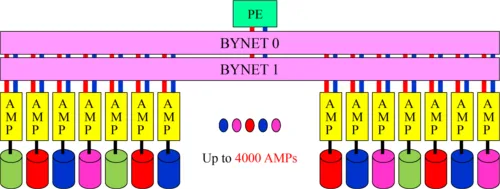
The largest systems in the world have used Teradata for market dominance for the past 20 years. Its Massively Parallel Processing (MPP) technology analyzes on such a large scale that companies can run queries they have never been able to run before. Recognize that you now have something very powerful and that has the ability to analyze every aspect of your business. So do what you’ve never done, and get something that you’ve never got.
AMPs and Parsing Engines (PEs) live inside SMP Nodes
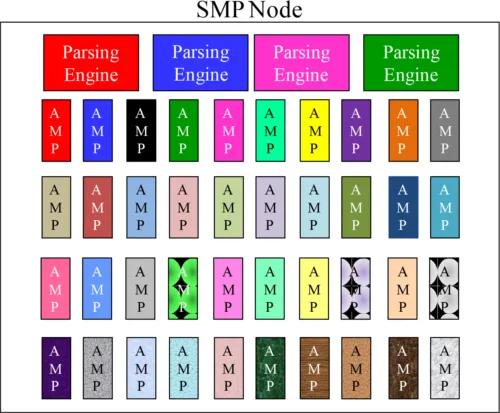
AMPs and PEs are called Virtual Processors because each is a process that lives inside a node’s memory. Think of a node as a very powerful personal computer. SMP stands for symmetric multi-processing which means each CPU processor performs equally, and all CPUs share a pool of memory and operate under one opera...